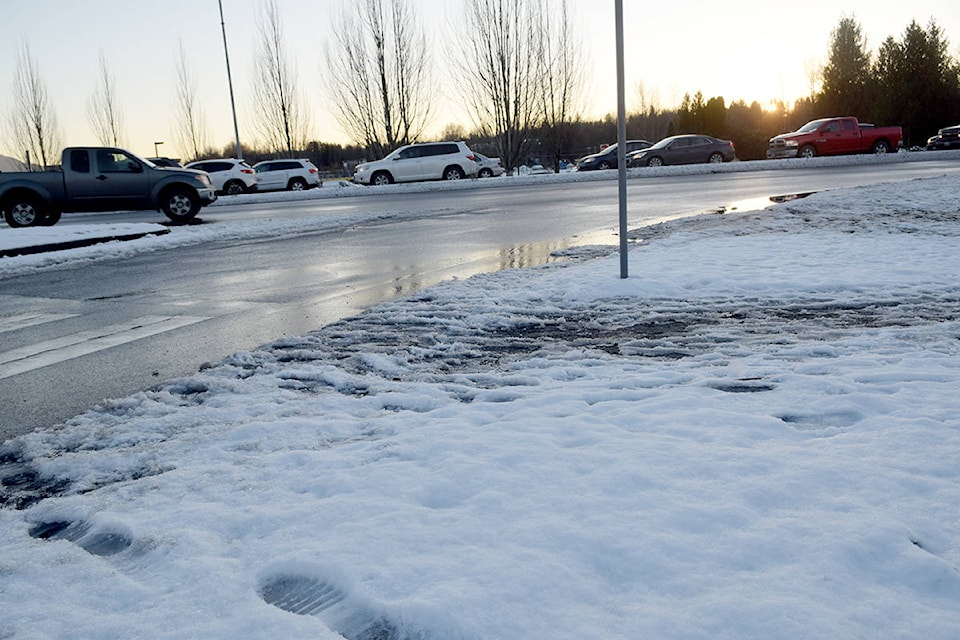They can’t all be built overnight – or even within the next couple decades – but a new concept plan for Abbotsford’s transportation network suggests adding more than 200 kilometres of sidewalks to the city’s streets.
The concept plan, which was presented recently to council by Urban Systems’ John Steiner, also suggests significantly beefing up transit in core areas, continued lobbying for highway improvements, and several major east-west road projects over the coming decades.
The ideas laid out in the plan will inform a draft plan to be crafted in the new year, and Steiner noted they could change significantly after consultation with the public.
While Abbotsford has around 429 kilometres of sidewalks, a third of all streets have no such place for pedestrians. The plan suggests major roads, and those with bus routes, should have sidewalks on both sides of the streets, and others should be located around schools, parks and other amenities. A map suggests the large residential area in central Abbotsford south of Peardonville Road is particularly in need of sidewalks.
Adding so many sidewalks, Steiner noted, will require significant and sustained capital investments over the coming years.
“It’s a very expensive plan and it would take well more than 25 years to achieve this,” he said.
On the transit side of the ledger, Steiner said the city can improve significant issues in the system as early as 2019. That would be done by altering routes and concentrating service in the core area, particularly along a future rapid transit corridor that would run from Highstreet in the west, down Maclure and then Old Yale roads, and onto South Fraser Way. From there, the line would run to the historic downtown, then south down McCallum Road toward the University of the Fraser Valley.
Service should consistently be every 15-20 minutes on weekdays, with weekend service intervals no greater than 30 minutes.
“Eventually you’d want it to be so someone doesn’t need a schedule to go out and catch transit on one of these corridors,” Steiner said.
By 2020, when a new transit depot becomes operational, the plan envisions a 10 per cent increase in service hours, with more to come in following years, depending on public desire. Steiner presented a chart showing Abbotsford currently has fewer hours and rides per capita than like-sized communities. Kelowna’s transit system provides twice as many rides per hour over twice as many hours of service.
The plan proposes to turn South Fraser Way into a “signature corridor” for cyclists, through the use of protected bike lanes. Elsewhere, it promotes the development of a network of “all ages and abilities” (AAA) bike paths separated from vehicle lanes, or on local streets with slow speeds..
Referencing the recent death of a young Abbotsford student, Coun. Brenda Falk asked about ensuring students have safe ways to get to school.
Peter Sparanese, the city’s general manager of engineering and utilities, said the city is “working with the school districts in identifying the safe-routes-to-school corridors.”
The plan also suggests the city is reviewing several potential major road projects, many with an eye on improving east-west traffic flow.
With traffic on McKee Road expected to grow over the coming decades, the plan says the city is eyeing it for widening it and potentially linking it to George Ferguson Way to directly connect the Sumas Mountain area to the city centre. Such a connector would include an overpass above Highway 11.
The city is also eyeing directly connecting Maclure Road with Sumas Way. Currently, the road jogs north at its easternmost extent.
The plan says the city is also considering the need to widen the remaining two-lane section of Old Yale Road and Eagle Mountain Drive, along with Marshall Road east of McMillan.
Such projects are often included in transportation plans but take years or decades to come to fruition, though.
Downes Road and King Road have also been identified as candidates for widening, but the report says that doesn’t appear to be needed within the 25-year lifetime of the plan.
Projects identified as short-term priorities include improvements to Highway 1 interchanges at Sumas Way and Whatcom Road, the widening of Highway 1, and the final linking of two disconnected parts of Marshall Road on Sumas Mountain.
The plan also highlights projects underway or slated for imminent construction, including the Marshall Road connector in west Abbotsford, the Highway 11/Vye Road project, Mt. Lehman widening, and centre-lane improvements to Fraser Highway.
